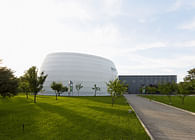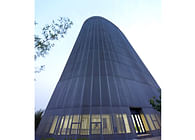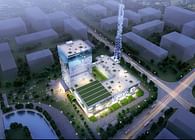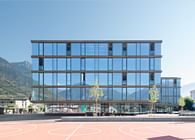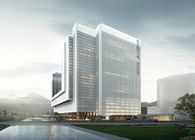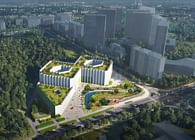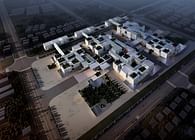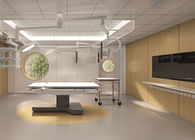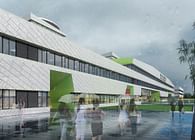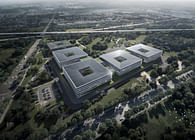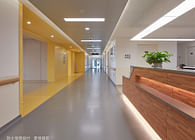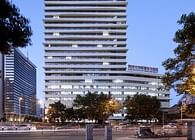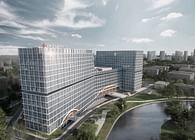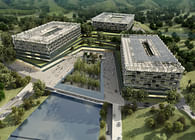
Switzerland, Montreux | Shanghai, CN
Nanjing is an ancient Chinese capital, a traditional city. It has also become a megalopolis, one of the most populated cities in the world, with its needs and problematics.
In the same way, the Drum Tower Hospital has evolved over time under various cultural backgrounds.
It is actually one of the oldest hospital in China, created by a Canadian missioner, Dr. Maclin in 1893. In the early eighties, Professor Qi Kang, a well-known Chinese academic in architecture, was commissioned to extend the existing hospital facilities, creating one of the largest hospital facilities in the world at the time. Today, the Drum Tower Hospital is the most important health structure in the whole of China.
One of the main intentions was to be able to continue this dialogue between history and modernity, occidental and oriental inputs alive in the project. When we talk about healing, we wish to speak about tradition, history and modernity at the same time; creating bounds as also part of a healing process.
When the most traditional typology all over the world, turns out as a functional block and a park. Lemanarc wished for something different, more profound and intimate. That would be an essential compositing part of the building. Instead, they decided to propose a low rise building, forming six big gardens at the center of the city.
Over time, the actual ‘Drum Tower’ from the Ming Dynasty became completely isolated at the north of the hospital. The historical axis generated from the Drum Tower, which was so important for a Chinese traditional city was totally forgotten.
On the other hand the other main historical axis from the Minguo period, at the east side is still there. Lemanarc believed that the project was a great opportunity to reunite the original spatial structures that formed the city as we know it.
This concept developed by creating the north part of the new hospital, the inpatient part, following the Ming’s dynasty’s axis, and letting the south part, the outpatient part, follow the Minguo’s axis.
Lemanarc believes that this would help the residents rediscover the value of those historical legacies.
After combining those two axis, a lot of interesting combination of forms came out, and they enabled to provide interesting answers to the various compels generated but such a vast and sophisticated program. By using these combinations and creating overlapping systems, Lemanarc created a series of courtyards that they prefer referring as “gardens” as in the traditional Chinese meaning.
Creating a clear gap in between the building and the surrounding environment in order to clearly isolate the visitor from the outside life. It does not only reflect functional efficiency, but also creates a sensation of safety and comfort. The Hospital is a shelter from our daily world, It’s a retreat, an island.
It is a difficult task to solve the mechanical and functional equation of such a vast and complex program without forgetting about its original purpose. It needs to be simple, intelligible, accurate, compact, fluid and yet it must still be a place of protection and support. Not just a technical but also a spiritual support.
In modern culture, it is inevitable, the hospital is the place where we all come from and where we all are going to go.
Lemanarc wanted to create a place that would immediately feel familiar and intimate; to be able to provide a safe environment. A place of serenity, where bonds of trust would come naturally.
In its original occidental interpretation, the word Hospital come from hotel/hospitality, in the sense of sheltering a concentration of patients or visitors. On the other hand, the Chinese word for hospital is ‘Yi Yuan’. Yi means healing, Yuan means garden; Yi Yuan literarily means ‘healing garden’.
A lot of daylight boxes are implanted inside of healing spaces. Anywhere you walk in this new hospital, you could find yourself close to an interior garden or a daylight space. This is the main key features which helps to provide a comfortable feelings for patients and staffs.
Learning from Chinese culture, Lemanarc decided to decompose the façade of the hospital into the following 5 functions and recombined those functions back to a modular prefabricated façade.
The 5 functions are:
Shading: The third layer, which is at the most exterior of the façade, is made by a hanging system of perforated aluminium board. It covers the entire façade creating an efficient shading system.
Greenery: Between the first and the third layer, Lemanarc designed a planter box, so that plants could grow in this space, protected against the wind by the 3rd layer of aluminium, and could be seen from inside room. This gives each room a close garden feeling.
Lighting: The second layer of the façade is made by a first face polished glace. This provides a smooth and soft white color light.
Wind: In between the second layer and the first layer, we integrated on each side a side an opening window, which allows natural ventilation parallel to the façade.
View: The first, second, third layers of the façade, forms different view frames, providing a unique relationship with the exterior landscape. The multi-layered facades with overlapping patterns recreate this sensation of smoothness and intimacy.
There is always a garden nearby each window to suggest a continuity between the inside and outside, recreating a familiar environment for the patient.
While China is confronted to massive consummation issues, through out a permanent dialogue with oriental and occidental culture, history and modern technologies, Lemanarc proposed more than just functional efficiency; they managed to bring out the true purpose of a healing facility. The city was expecting a huge healing machine; instead they provided a spiritual garden.
Status: Built
Location: Nanjing, CN
Additional Credits: Design team: Vincent Zhangmao Zhang Daniel Pauli Ma Rong Anja Schlemmer Rolf Demmler, Dirk Weiblen, Bjorn Anderson,Dagma Nicker, Cui Xiaokang, Mao Yu
Photography: Xia Qiang

